The X-Pulse 90 is a new benchtop nuclear magnetic resonance (NMR) spectrometer, the first of its kind to offer broadband NMR at 90 MHz. This instrument is ideal for flexible chemical analysis, as it can investigate a wide range of nuclei across various applications without compromising performance.
X-Pulse 90 maintains the X-Pulse philosophy of modularity, flexibility, and upgradeability, allowing it to be customized to user requirements, such as adding a flow cell for real-time reaction monitoring or incorporating variable temperature functionality.
The distinctive, user-replaceable probe also allows the setup to be adjusted easily based on specific needs (e.g., optimizing for the highest signal-to-noise ratio or multiple nuclei) and provides convenient access for cleaning.
X-Pulse 90
Video Credit: Oxford Instruments
X-Pulse’s Unique Features that will Benefit the Workflow
- Broadband capability allows the spectrometer to measure the widest range of nuclei on a benchtop instrument without compromising sensitivity.
- A wide variable temperature option of 0-60 °C enables users to thoroughly investigate reaction kinetics and characterize electrolyte properties.
- The optimal orientation of the diffusion gradient ensures accurate measurements, even during flow experiments.
- User-exchangeable probes offer versatility without compromising sensitivity.
- The probes can be easily removed to minimize machine downtime from spills or breakages.
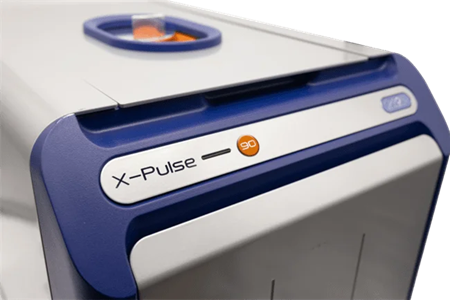
Image Credit: Oxford Instruments
Explore X-Pulse 90:
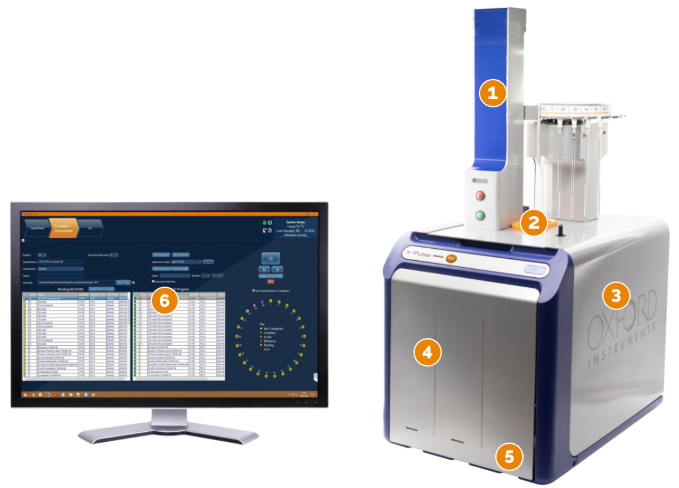
Image Credit: Oxford Instruments
1. Autosampler
The X-Pulse 90 can be upgraded with the X-Auto, a 25-position auto-sampler that enables automated data collection and significantly boosts productivity.
2. User Exchangeable Probes
The X-Pulse 90 is the only benchtop NMR spectrometer with user-exchangeable probes, making it easy to maintain and highly versatile for various applications.
- 1H 19F only probe for high SNR
- Broadband for maximum flexibility
3. Flow Cell
Using a flow cell, the X-Pulse 90 makes real-time reaction monitoring and mechanistic studies simple. The precisely oriented diffusion gradient ensures accurate measurements even while a sample is flowing, and the spectrometer's excellent stability guarantees that any changes users see in the data are due to the reaction.
4. Versatile Configuration
Set up the X-Pulse to detect a wide range of nuclei.
- Dual-X – 1H/19F/ Select two nuclei from the broadband frequency range
- Broadband – 1H/19F/ Fully tuneable 29Si – 31P
5. Variable Temperature
The X-Pulse 90 combines high sensitivity with the widest variable temperature (VT) range on a benchtop NMR spectrometer (0-60 °C). This powerful combination allows for a comprehensive understanding of reaction kinetics, enabling users to study a broader range of reactions and investigate the behavior of mixtures at different temperatures.
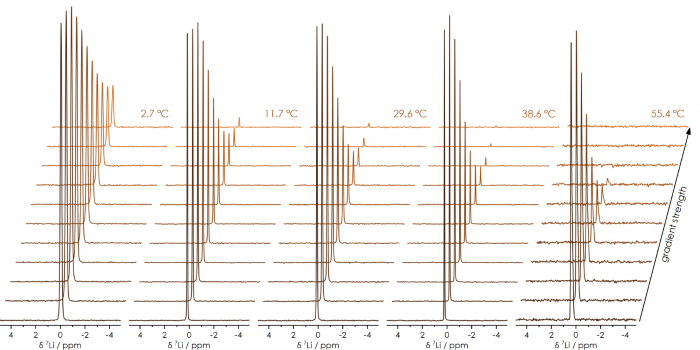
Variable Temperature. Image Credit: Oxford Instruments
6. Software
Data acquisition software, SpinFlow, is highly versatile, enabling users to:
- Execute one-click experiments for faster data acquisition
- Adjust parameters to obtain precisely the data needed
- Run custom pulse sequences created in Python®
- Streamline the workflow using the queue function or by integrating with an autosampler to accelerate data collection.
Broadband
X-Pulse 90 is the only 90 MHz broadband benchtop NMR system globally, allowing tuning and matching across a broad spectrum of nuclei within a single compact instrument.
- Sensitivity: 240:1 for 1 % Ethyl Benzene
- Resolution <0.35 Hz (50 %) / <15 Hz (0.55 %)
- Pulsed field gradients as standard (>0.5 T/m)
- X-Channel: fully tunable 29Si – 31P (38 possible nuclei)
- No cryogens
- Standard 5 mm OD NMR tubes
- Suitable for all levels of users
Accessories:
- Variable temperature option (0 °C – 60 °C)
- X-Auto: 25-position auto-sampler
- Flow NMR option
Dual X
The X-Pulse 90 Dual-X benchtop NMR system is capable of analyzing up to four different NMR-active nuclei in a single instrument.
- Standard 5 mm OD NMR tubes
- Pulsed field gradients as standard (>0.5 T/m)
- Resolution <0.35 Hz (50 %) / <15 Hz (0.55 %)
- Sensitivity: 240:1 for 1 % Ethyl Benzene
- X-Channel: select 2 nuclei from 13C, 31P, 7Li, 29Si, 11B, 23Na, and more
- No cryogens
- Suitable for all levels of users
Accessories:
- X-Auto: 25-position auto-sampler
- Fully upgradable to X-Pulse broadband
- Variable temperature option (0 °C – 60 °C)
- Flow NMR option
HF
The X-Pulse 90 HF is a single-channel benchtop NMR instrument that offers exceptional sensitivity.
- Standard 5 mm OD NMR tubes
- Resolution <0.35 Hz (50 %) / <15 Hz (0.55 %)
- Suitable for all levels of users
- Sensitivity: 320:1 for 1 % Ethyl Benzene
- Pulsed field gradients as standard (>0.5 T/m)
- No cryogens
Accessories:
- Fully upgradable to X-Pulse broadband or X-Pulse Dual-X
- Variable temperature option (0 °C – 60 °C)
- Flow NMR option
- X-Auto: 25-position auto-sampler
Why Benchtop NMR Spectroscopy
Benchtop NMR is a non-invasive and non-destructive spectroscopic technique that provides valuable structural and quantitative insights into liquid chemical samples with minimal preparation. Since the instrument is portable, it can be easily integrated into any lab.
When equipped with a flow cell and broadband capabilities, the X-Pulse 90 can be used to monitor many nuclei within a sample in real time. To speed up the analysis even further, the X-Pulse 90 can be fitted with a 25-position autosampler that enables hands-free data collection, reducing the time spent in front of the instrument and maximizing its use.
Choose the Nuclei
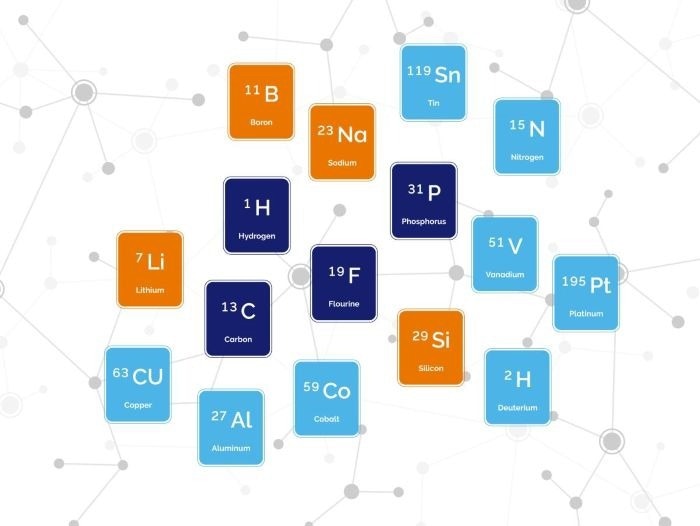
Nuclei. Image Credit: Oxford Instruments
The X-Pulse 90's freely tunable broadband channel, which spans from 29Si to 31P, makes it the most versatile benchtop NMR spectrometer on the market. This feature allows the user to select the exact nuclei needed for their research.
For instance, 1H, 13C, and 7Li for battery research; 29Si for polymer studies; or less common nuclei such as 55Mn, 59Co, and 195Pt for catalysis or inorganic synthesis.
The Power of 90 MHz Performance
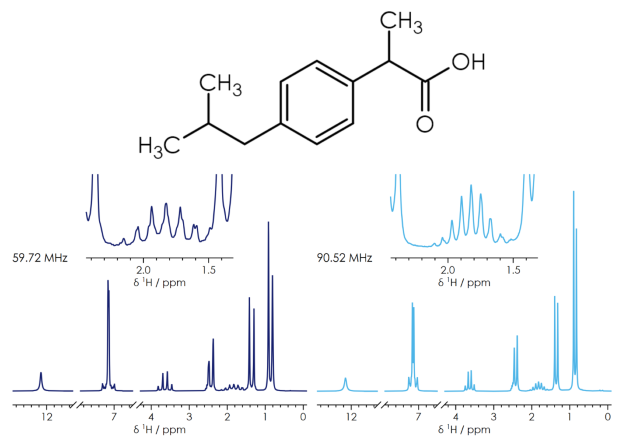
Image Credit: Oxford Instruments
With a powerful 90 MHz (2.1 T) magnetic field, the X-Pulse 90 helps users easily resolve challenging peak overlaps, making it simple to identify compounds of interest in samples. The increased spectral dispersion means that a peak that was previously difficult to distinguish is now clearly separated and identifiable.
The enhanced sensitivity of the X-Pulse 90 also enables the detection and accurate measurement of molecules at lower concentrations, which is ideal for mass-limited samples or when dealing with active pharmaceutical ingredients (APIs). The combination of high sensitivity and peak separation allows for much faster 2D experiments, even on larger molecules.
Easy Operation
SpinFlow, easy-to-use acquisition software, is designed for all users, from experts to infrequent operators.
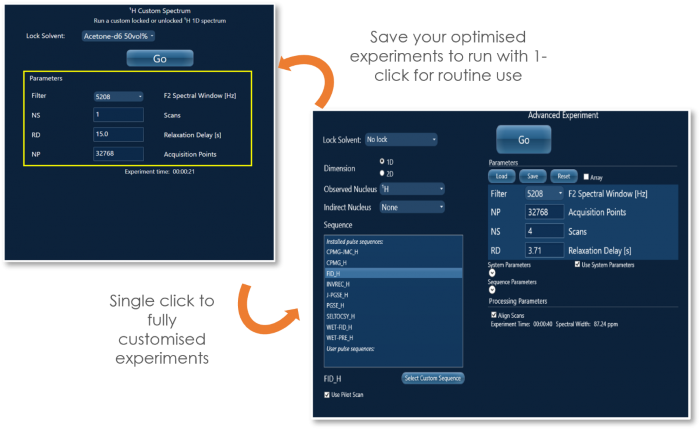
Image Credit: Oxford Instruments
Features
- Collect 1D and 2D NMR data with one click using pre-set experiments.
- Set and save your own custom parameters and experiments.
- Create and save experiment queues for consistent data acquisition.
- Write and execute own pulse sequences in a Python®-based language, giving full control over the spectrometer.
Related Applications
- Agriculture and Food
- Chemistry Research
- Chemical Manufacturing
- Batteries
- Pharma
- Polymers
- Teaching NMR
- Industrial Applications